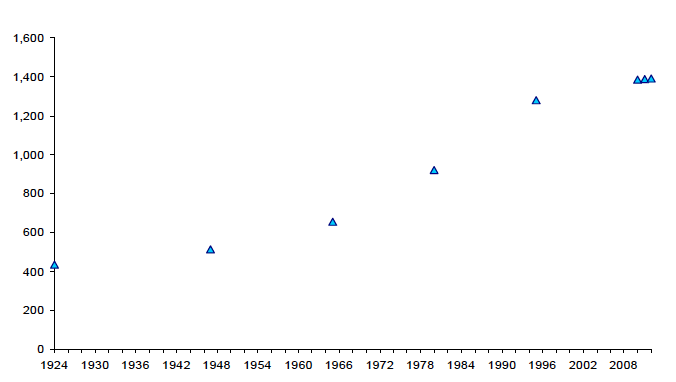Key Scottish Environment Statistics 2012
This publication aims to provide an easily accessible reference document which offers information on a wide range of environmental topics. It covers key datasets on the state of the environment in Scotland, with an emphasis on the trends over time wherever possible.
This document is part of a collection
Area of Woodland: 1924-2012 P,[17]
Area (thousand hectares)[18]

The extent of woodland[19] is of significant environmental importance. Woodland provides wildlife habitats and affects the physical environment, and is valued as a location for recreation and for its contribution to the landscape. It can also contribute to the sustainable production of wood products and paper, and provides a source of renewable energy.
In 2012, the area of woodland in Scotland was 18.0% of the total land area, compared with 5.6% in 1924 and 11.8% in 1980. 76% of this area is made up of conifers, both native and introduced such as Sitka spruce, larch and Scots pine with the remaining 24% made up of broadleaved species, again both native and introduced.
Forestry Commission Scotland manages the National Forest Estate on behalf of Scottish Ministers, which accounts for around one third of all woodland in Scotland. The remaining two thirds is owned by private owners including environmental Non-Government Organisations and community bodies, as well as by other public bodies.
Planting and management of non-Forestry Commission Scotland woodland is normally carried out with the assistance of government grants. The UK Forestry Standard sets out the standards for the sustainable management of all forests in the UK. Independent certification schemes for sustainable forest management are based on this Standard. In 2012, 58% of Scotland's woodland area (807,000 hectares) was certified as sustainably managed, accounting for just over 80% of all timber production.
New planting of woodland peaked in the late 1980s with around 25,000 hectares of new woodland being created annually. New planting has declined steadily over the last two decades to a low of 2,700 hectares in 2009-10 but has recently begun to rise again and 9,000 hectares were planted in 2011-12.
Source: Forestry Commission[20] / Metadata
Contact
Email: Sandy McPhee
There is a problem
Thanks for your feedback